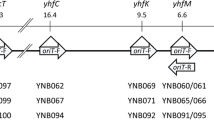Abstract
The ability of conjugative plasmids from six different incompatibility groups to mobilize a set of mobilizable plasmids was examined. The mobilization frequencies of plasmids RSF1010, ColE1, ColE3, and CloDF13 varied over seven orders of magnitude, depending on the helper conjugative plasmid used. Mobilization of CloDF13 was unique in that it did not require TrwB, TraG or TraD (all members of the TraG family) for mobilization by R388, RP4 or F, respectively. CloDF13 itself codes for an essential mobilization protein (MobB) which is also a TraG homolog, only requiring a source of the genes for pilus formation. Besides, CloDF13 was mobilized efficiently by all conjugative plasmids, suggesting that TraG homologs are the primary determinants of the mobilization efficiency of a plasmid, interacting differentialy with the various relaxosomes. Previous results indicated that TraG and TrwB were interchangeable for mobilization of RSF1010 and ColE1 by PILW (the pilus system of IncW plasmids) but TraG could not complement conjugation of trwB mutants, suggesting that additional interactions were taking place between TrwB and oriT(R388) that were not essential for mobilization. To further test this hypothesis, we analyzed the mobilization frequencies of ColE1 and RSF1010 by the P, W, and F pili in the presence of alternative TraG homologs. The results obtained indicated that the frequency of mobilization was determined both by the particular TraG-like protein used and by the pilus system. Thus, TraG-like proteins are not generally interchangeable for mobilization. Therefore we suggest that the factors that determine the frequencies of transfer of different MOB regions are the differential interactions of TrwB with pilus and relaxosome.
Similar content being viewed by others
Author information
Authors and Affiliations
Additional information
Received: 9 September 1996 / Accepted: 17 December 1996
Rights and permissions
About this article
Cite this article
Cabezón, E., Sastre, J. & de la Cruz, F. Genetic evidence of a coupling role for the TraG protein family in bacterial conjugation. Mol Gen Genet 254, 400–406 (1997). https://doi.org/10.1007/s004380050432
Issue Date:
DOI: https://doi.org/10.1007/s004380050432




